by Eric Meier
Within the massive Quercus genus, oak species are subdivided into a number of sections, though all commercially harvested New World oaks can be placed into one of two categories: red oak, or white oak. This division is based on the morphology of the trees themselves—for instance, red oaks have pointed lobes on the leaves, while white oaks have rounded lobes.
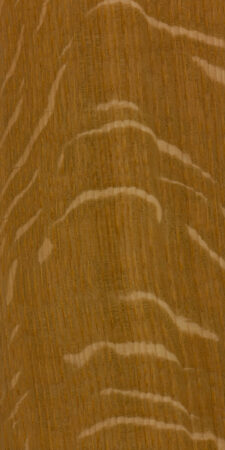
But in addition to the leaves and outward appearance of the trees, the wood of the various oaks also have a few important distinctions. Most notably, white oak is rot resistant, while red oak is not—an important detail for boatbuilding and exterior construction projects. White oak also has a unique ray fleck pattern when perfectly quartersawn that’s seen more often in antiques—a figure that’s sometimes called “tiger oak” in antique furniture circles.
It should be noted that red oak also has conspicuous ray fleck patterns on its quartersawn surfaces, but it’s generally just not quite of the same caliber and size as white oak. (See this quartersawn picture of red oak for reference.)
Oak lumber: Superficial color differences
While there is one specific wood species (Quercus alba) that’s commonly considered the “white oak,” and there is one specific species (Quercus rubra) that’s considered the “red oak,” when you buy oak lumber within North America, oftentimes you will not actually be buying these two exact species, but instead you may be buying one of the oaks contained within the two broad red and white groupings. Basically, you’re buying characteristics found in an oak group, and not necessarily an exact species. For the rest of this article, I’ll be referring to red oaks and white oaks (plural) as two different groups of trees, and not simply as individual species.
At a casual glance, unfinished oak lumber will generally be light brown, either with a slight reddish cast (usually red oak), or a subtle olive-colored cast (white oak). However, there are abnormally light or dark outliers and pieces that are ambiguously colored, making separation based on color alone unreliable—this is especially true if the wood is finished and/or stained.
Nonetheless, it can be helpful to get a baseline view of the typical color that’s seen in red and white oaks. Listed below are small thumbnails of various oak species in their raw unfinished form, arranged in either the red or white oak grouping. Comparing the two groups is simultaneously helpful and also confusing. You’ll notice that there’s a general categorization of color that most samples fall into (helpful), but you’ll see that there’s also no hard and fast rule to easily tell the two groups apart by color (that’s the confusing part).
Red oak group
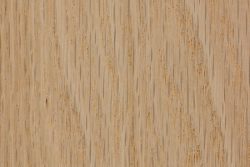
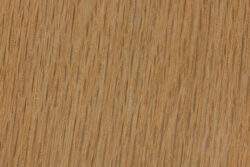
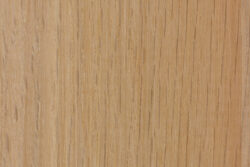
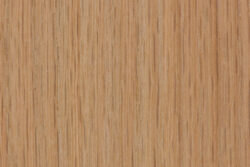
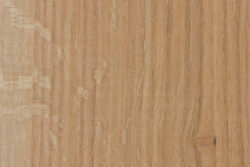
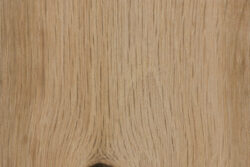
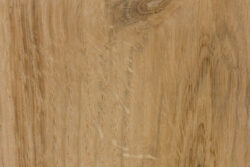
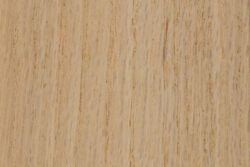
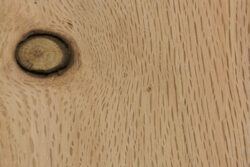
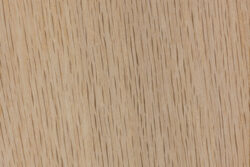
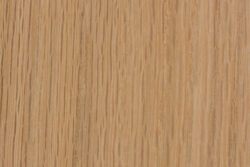
Looking at the examples above, you may notice a loose pattern where red oak species tend to have a slightly paler and redder hue on average, while white oak species have a slightly more olive hue. There are of course outliers and individual variation from tree to tree, so the above grain samples should by no means be meant as an accurate representation of any of the species as a whole.
But realistically, even if you can discern a pattern in the red/olive dichotomy of oak coloration, you can hopefully also see how much overlap and unpredictability there are between pieces.
Tips for actually telling red and white oak apart
In most cases, we won’t have access to the tree or its leaves, so all we have to go on is the wood itself. Here are some ways of telling types of oak apart that tend to be a little more reliable than using color alone.
1. Look at the endgrain
A quick and fairly reliable way to tell the two oaks apart is simply by looking at the endgrain. In order for this to work, the ends of the board can’t be painted, sealed, or rough-sawn. A freshly cut oak board should be easy to distinguish:
The pores found in the growth rings on red oak are very open and porous, and should be easily identifiable. White oak, however, has its pores plugged with tyloses, which help make white oak suitable for water-tight vessels, and give it increased resistance to rot and decay. The presence of tyloses is perhaps the best and most reliable way to distinguish the two oaks, but it comes with a few caveats:
1.) Make sure that you’ve cleaned up the endgrain enough to see the pores clearly, and blown out any dust from the pores. You don’t want a “false-positive” and mistake sawdust clogged in the pores for tyloses.
2.) Make sure that you’ve viewing a heartwood section of the board in question. While white oak has abundant tyloses in the heartwood, it is frequently lacking in the sapwood section.
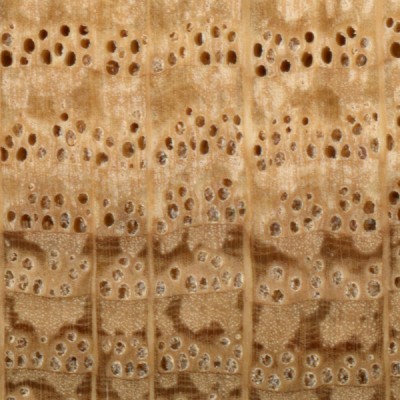
One related test regarding porosity is to take a short section of oak and try to blow air through the pores. If you are able to blow anything through it at all, it’s probably red oak. Take a look at this video, where a red oak dowel was used to blow bubbles in water:
One exception to this rule is chestnut oak, which is still considered to be in the white oak group, even though its pores are open like red oaks.
2. Look at the rays
When looking at the face of the board, especially in the flat-sawn areas, you may notice little dark brown streaks running with the grain, sometimes referred to as rays.
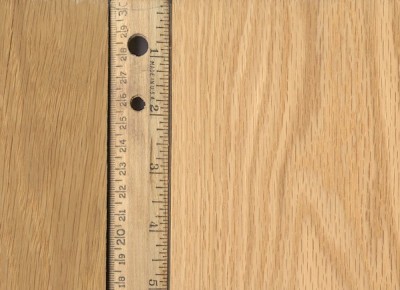
Look closely at the picture above, (click on it to enlarge it if you have to), and note the length of the rays in both types of wood. Red oak will almost always have very short rays, usually between 1/8″ to 1/2″ long, rarely ever more than 3/4″ to 1″ in length. (Pictured above on the right.)
White oak, on the other hand, will have much longer rays, frequently exceeding 3/4″ on most boards. (Pictured above on the left.)
This method is probably the most reliable under normal circumstances, and is useful in situations where the wood is in a finished product where the endgrain is not exposed.
3. Use sodium nitrite
This technique is sometimes used at sawmills if various logs need to be sorted out quickly. Instead of taking the time to analyze each log closely by hand, a 10% solution of sodium nitrite (NaNO2) is sprayed or brushed onto the wood and observed. If it’s red oak, there will only be a small color change, making the wood only slightly darker. But if it’s white oak, there will be a noticeable color change in as little as five minutes, (though it can take longer if the wood is dry, or if the temperature is low). The heartwood of white oak will eventually change to a dark indigo to almost black.
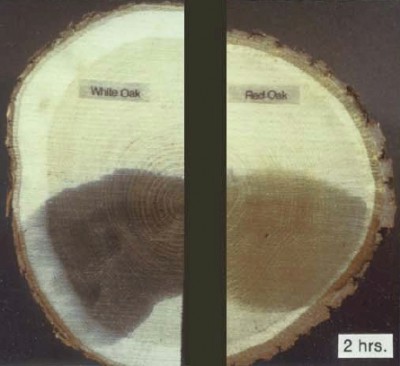
This method is extremely accurate and reliable, though in most instances, it’s probably overkill. However, if you’re ever in a situation where you can’t separate between red and white oak based on anatomy, this method is nearly foolproof. (Though, only the heartwood will bring about the color change, not the sapwood.)
First, you have to obtain some sodium nitrite (NaNO2). You may be able to find some locally through chemical supply stores, but they typically only sell in bulk quantities, making such a small project prohibitively expensive. However, some online retailers have the chemical for sale in much smaller quantities, bringing it into reach of most that are curious about oak identification.
Next, you need to mix up a roughly 10% solution of sodium nitrite by weight. This ratio actually isn’t as critical as it seems: solutions as small as 1% and as high as 20% have all been used with success, but to err on the side of caution, we’ll use the most appropriate quantity recommended.
Recipe for 10% Sodium Nitrite Solution for Testing Oaks:
- 1 cup water
- 4 teaspoons sodium nitrite
Directions: Stir in sodium nitrite until clear. Clearly label solution to avoid confusion; sodium nitrite is very dangerous if ingested.
All that’s left is to simply brush this solution onto a raw wood surface and wait for a reaction. With dried wood stored at room temperature, this reaction should take about 10 minutes. Red oak will be only slightly discolored by the solution, sometimes developing a slightly greenish hue, while white oak will gradually turn a dark reddish brown, eventually turning a deep indigo to nearly black.
See the progression photos below for a better look. (Also note that around the 8 and 15 minute marks the water begins to evaporate from the surface of the wood, but the color is still present after the wood has dried, as indicative of the 25 minute photos.)
TIME | RED OAK | WHITE OAK |
| raw | 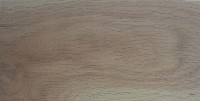 | 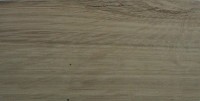 |
| 1 minute | 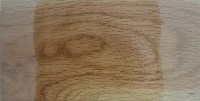 | 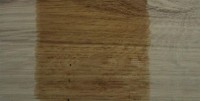 |
| 5 minutes | 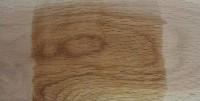 | 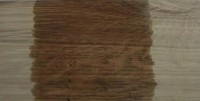 |
| 8 minutes | 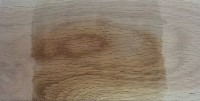 | 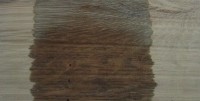 |
| 15 minutes | 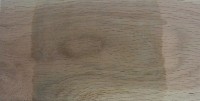 | 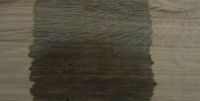 |
| 25 minutes | 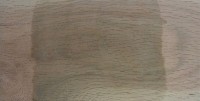 | 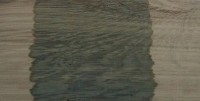 |
Why you’d want to tell red oak from white oak
As to the reasons why you’d want to be able to distinguish between the two, most of the answers have been explained above, but I’ll recap:
- White oak is much more resistant to rot, and is suitable for water-holding applications, boatbuilding, outdoor furniture, etc.
- Red oak should only be used for interior pieces such as cabinets, indoor furniture, flooring, etc.
- White oak tends to be more dense, while red oak is a bit lighter and has a more porous and open grain.
- White oak is usually slightly more expensive than red oak.
- White oak has larger and more pronounced ray flecks when perfectly quartersawn and historically has been used more often in antiques than red oak.
Get the hard copy
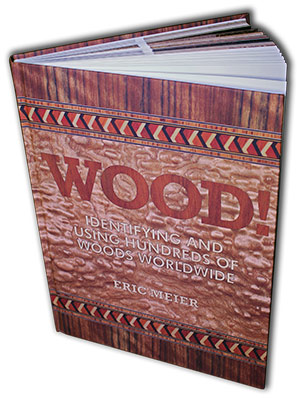

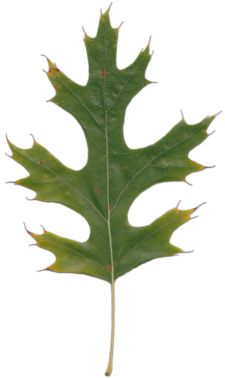
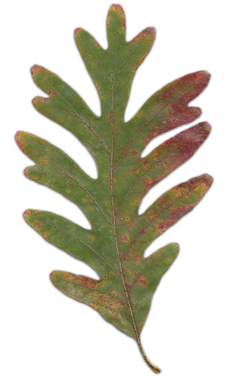
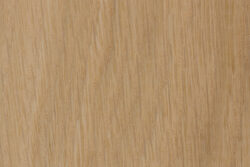
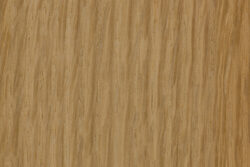
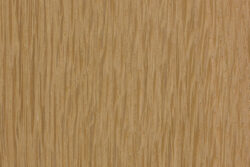
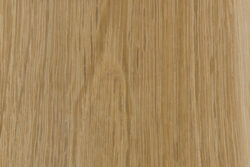
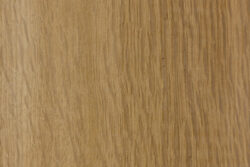
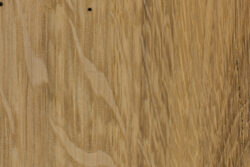
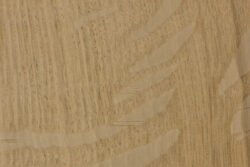
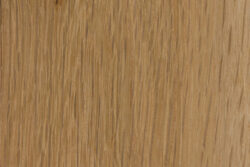
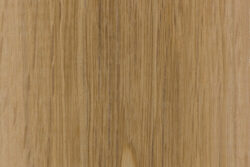
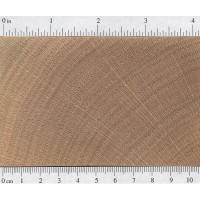
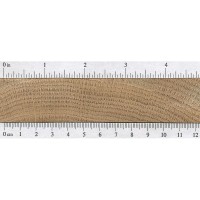
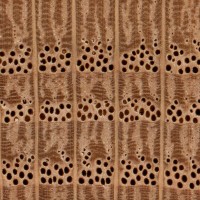
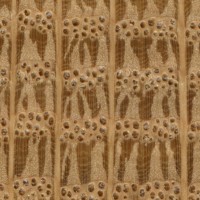



I’ve been going crazy trying to determine if this is red or white oak. It’s 2 1/4″ x 3/4″ tongue and groove flooring from my 1952 ranch home in the Pacific Northwest.
I sanded a bit in front of the fire place to get a sense of its true color (first photo) and the second photo is a comparative of sanded and the original finish floor.
I need to replace a few damaged sections and everyone has different opinions!
I would say based on the very short rays, it looks more like red oak to me.
Best article I’ve found on the details between the two, thank you. What do you think this is? I bought it to use as deck railings thinking it was white, but now I’m not sure. Would red be ok for a deck railing of properly oiled/sealed?
Thanks!
It can be tough when looking for tyloses in the endgrain since the cut has to be really clean, or else you could lose the needed details in the roughness of the grain/cut. But it looks like white oak to me. I wouldn’t recommend red oak for an exterior railing.
Red Oak or White Oak??? Or is it even Oak at all? I don’t know if it helps, but it is a VERY heavy table, just sanded all down as my daughter poured nail polish remover on it and ruined the finish. Also, would you stain this wood or just use a polyurethane?
Not oak, it looks like rubberwood. https://www.wood-database.com/rubberwood/
Rubberwood takes stain well if you can be sure to remove all of the old finish.
We had one flooring guy tell us this is Red Oak, and one tell us this is White Oak. I think it is White.
Hello sir, is this red or white?
60 year old hardwood floor in Maryland. Sanded and 3 coats Natural Satin Poly in 2005. Has amber patina (Poly?) Have had different flooring folks tell us it is Red….and white Oak. We think it is white. If we put down unfinished in Kitchen and do the same Natural Satin Poly will it Patina to match with time? Don’t really want to sand 2000 sf of hardwood.
I’d say that oak is one of the hardest flooring woods to match, especially given such a great difference in age in most replacement/expansion projects. Maybe finish a few test planks before installing, and hold them next to the existing floor to see if they come close to a match. Consider using a very light stain if needed to get a better match. Personally, I wouldn’t chase the illusive “it’ll match someday” thought, but to each his own.
Hi Eric. I could use your help/opinion on this. Shortly, I will be turning a Celtic wedding (i.e., double captive ring) goblet as a wedding gift to our son and his fiancé. The wedding location has a large old oak tree on the property, so I wanted to turn the goblet from oak. Any thoughts as to which species would be better for this turning project… Red or White Oak? Thank you.
If you’re going to use oak, then I’d lean towards white since it has better rot resistance, even if it is not exposed to elements. Red oak doesn’t react well to liquids and can get discolored.
Is this oak
No, that’s not oak. I can’t get a positive ID from that pic, but I can tell it’s not oak.
Here’s another pic
Hi Eric, most of our floors date to the late 1930s – we want to replace the areas that are tiled with matching/similar hardwood. My initial guess was white oak but there are a lot of water (dog) stains, especially at the ends of the boards which makes me think red? Any thoughts before I try the nitrite would be a huge help.
The ray fleck pattern looks a lot like white oak to me. If you wanted to try to match this, you’d want to try to find flooring planks that are specifically sold as quartersawn.
Hi, could you please help me identify this type of wood?? I’d be very grateful, we cannot find it anywhere.
thanks
Looks like white oak to me.
Neighbor gave me a butt log he had identified as white oak (for me to use making Windsor chairs). When the log was opened up it was rather red in color. I sent sample off to be identified and the results say “white oak group” which has really thrown me! So if you happen to know: which oaks in the “white oak group” tend to be reddish in color when split open??
Thanks!
John
Hi Eric. Good explanation. I am trying to make a decision on hardwood floor and wanted to know the below details
I can’t tell type of oak in that picture as the stain is very dark and obscures the rays. I’ve never heard of Columbia hills oak, it sounds completely made up, and it doesn’t surprise me as it probably just a name to sell flooring (flooring dealers are notorious for this).
I am guessing red oak. What do you think?
I agree, red oak.
Images didn’t attach before
I’m sorry, I can’t tell from that distance. I think in addition to the species, there is also the question of age. Older boards with a natural patina perhaps many decades old will tend to be darker than brand new wood. It’s important to adjust expectations, especially with older oak floors.
Any better?
The piece on the far left looks more like white oak, while the piece front and center looks like red oak.
Thanks! That’s what I concluded but feel better with confirmation.
Eric
Extending our wood floor as we create an open floor plan. I’ve had multiple people try to determine if we have white or red oak. I get various answers.
attached is our current floor – no stain just waterbase coat
I’m ready to order but hesitant to purchase incorrectly.
Could you help us identify this barn wood, was apparently used in a ohio barn in 1800s, we have stacks of 1 by 8 boards, one side had paint , the other is side in pics, we used clear polyurethane on small section and it stained very dark? The wood is very hard.
The grain almost looks like one of the denser softwoods like douglas fir or southern yellow pine to me, but I can’t tell much from those pics. Can you clean up/sand the grain and repost pics of the face and end grain?
Hi Eric –trying to send again- I would greatly appreciate your opinion on the attached photos. I just had a white oak floor put in and now after the first 2 coats of Bona stain went down there are several boards that stick out noticeably more reddish in color. I’m not sure what you are referring to when you say to look at the “Rays” and was hoping you might be able to tell from the photos whether you suspect any or all to be red oak? Many thanks in advance!
Based on the rays (the thin, dark lines running parallel with the grain), the ones that look more like red oak in your side by side comparison pics are the pieces on the left. Color-wise, those may actually be opposite of the ones that you describe as being more reddish in color. Not sure if I’d be 100% confident without seeing the endgrain. There is a fair amount of color variation in oak as it is, so it can be important to sort and select based on color for consistency.
Thanks for the reply – appreciate your input!
I am trying to determine if the paneling in this picture is white or red oak. Wil be used on an outside porch and be exposed to the elements.
Thanks
Hmm, sometimes you can tentatively ID oak based on the pattern of the ray fleck on quartsawn surfaces. To me, it looks like white oak, but I don’t know if I’d trust that enough alone to place it outdoors.
Here’s a closer look of the cabinet door.
Hi Eric,
I am looking to pinpoint the wood in the picture. I think it’s oak but the long rays, pale color, minimal graining and darker rays have me thinking otherwise. How would one achieve this color if it is stained? Can this look be achieved with a laminate? Thank you so much for your help!!
Can’t make out very much detail in those pics, sorry. I can’t see any rays in your pictures at all. It doesn’t look like oak to me.
The ray is the gray/mauve upside down swoop is it not? What would you guess the type of wood it be if you had to guess?
No, rays appear as small dark slits that run parallel to the grain. I don’t even know what continent you are from, and I can’t really tell if what I am looking at is real wood based on your pictures so far.
No worries, thank you for your help.
I am would like to strip and restain these cabinets and attempt to get away from the yellow tones. Are you able to distinguish what species of Oak these are from?
Thank you!
I can’t tell the type of oak, but if you’re staining, it should make too much of a difference. Both will take stain very well and have same working characteristics.
Hi Eric – I wood (pun intended) greatly appreciate your opinion on the attached photos. I just had a white oak floor put in and now after the first 2 coats of Bona stain went down there are several boards that stick out noticeably more reddish in color. I’m not sure what you are referring to when you say to look at the “Rays” and was hoping you might be able to tell from the photos whether you suspect any or all to be red oak? Many thanks in advance! Mark Post post edit: I tried to attach pics but… Read more »
No photos attached. Maybe check file size and retry?
I purchased this kitchen table a few years ago. As you can see from the picture, it got a scratch in it. The finish is also disintegrating in spots. The chairs are in great shape so I only want to redo the top. I think after reading your article it is red oak. I am sure it is stained so I know matching the color will be a project in itself. My question are: Will being red or white oak make a difference in the stain color? Like would Colonial Maple look the same on either red or white? Do… Read more »
Color shade differences would be very slight, especially since it’s going to be stained. You may want to buy a stain with about the right tint/hue, but slightly paler, and apply multiple coats to slowly darken it to the right color.
Thank you.
Would this be red or white, I did read the article but still am unsure. Thank you!!
Id say white oak because of how long the rays are. Then again I’m here. so I’m also just learning. This is fun, like school when you’d have to do a quiz to be sure you were paying attention to your notes
Is this better?
Judging by the ray height in those pics, it looks more like red oak to me.
Thank you.
Can anyone tell if this is red or white oak?
Can’t make out enough detail in that picture to tell, sorry.
No worries! Thank you Eric. I will try to get a better one.
Hi do you know if this is red or white?
photos
I think I can just make out some ray fleck on the front edge (which would be a quartersawn surface) of the middle step in your photo. That would at least suggest that it could be oak. To me, the stain is pretty ugly, it doesn’t look like the planer marks were sanded out at all before staining, but technically I think it’s still possibly oak.
Thanks Eric! I am having them look into the staining.
Hi Eric, builder says this are oak stairs. Handy man carpenter not sure if oak. What do you think?
Hey Eric,
Hardwood floor guy said this looks is white oak and said we wouldn’t know for sure until we do a chemical test… but looks an awful lot like red oak.
What’s you’re take?
Best,
Taylor
It looks more like white oak to me too. See point #2 in the article above — look at the rays.
Hi Eric, I just grabbed these logs from a recently felled tree in my neighborhood, it’s winter so I didn’t have leaves or acorns to go off of. Any recommendations on finding the type before I rough saw and dry them is very appreciated.
I can’t tell from the pic, sorry.
Not a problem! Fantastic article, and very helpful for the future. I’ll update with a higher quality picture and results following milling and a chemical test. Thanks again.
Hi Eric, What are your thoughts on this bit of timber? in its previous life it was used as part of a timber bog matt for heavy machinery. dimensions are 300x300mm and 6m long. I think it may be a species of oak but unsure what type of oak it may be? or is it another species of tropical wood
To me, that really looks like a softwood species of some sort. Possibly spruce or fir? Can’t tell too much more than that from the picture though.
Hi Eric, attempting to match flooring from 1979. Are you able to identify the wood?
Looks like red oak.
Thank you, much appreciated.
Hi I was hoping to confirm the attached is red oak- then again I may be very wrong :) Eric R
It looks like oak, thought it might be stained ash instead. It’s very hard to tell since the stain color could be perfectly hiding the rays, which is what should be at least slightly visible if it were oak.
Hello Eric, I am actively stripping paint from my cabinets (I love wood cabinetry). Once they are all cleaned up, I plan to stain them. Can you tell me what type of wood I have. I think it’s oak but I’m not sure
Yes, oak
Thank you!
Hi Eric, I am having a hard time telling if my oak is white, red, or a combination of both? Are you able to tell the type of oak in my picture? Thanks in advance for any help you are able to provide!
Looks like red oak.
Thanks so much!
Hi Eric…I have stair treads I’m needing to match. I’m thinking this is white oak, but not sure. Was hoping you might be able to tell? The tread is what I’d describe as ‘butcher block’ looking with each of the ‘blocks’ about 2 inches wide. Just trying to get a close match as we will be likely doing a carpet runner with about 4″-6″ exposed on each side and stained. Thoughts? And thank you, in advance!
Yes, white oak. I think in addition to matching the species, it’d be helpful to try to match the grain as closely as possible too.
Thank you, sir!
Hello, maybe you can help me Erik. Would you say this is Tiger Oak?
Yes.
Thank you!
Dear Erik.
I need your opinon, does the picture looks like oak to you? we bought white and red oak for our flooring (like in the short samples), but when it arrive, the color and the patterns of the wood looks so different that we are not sure if they sail us what we payed.
Thank you so much
I can’t tell for sure from the pictures, but I do see large ray fleck, which is characteristic of oak. The oak samples that you have appear to be a weathered gray, which might account for the color difference.
Hi, this is our sanded oak floor from 1951. Was patched and added onto with red oak and it looks so different I’m wondering if it was a mistake. In the last photo you can see the floor change from lighter (new floor) to darker, and the grain seems much busier than the original floor. Any insight? Thanks in advance!
I can’t really make out the transition line very clearly in the pictures. Can you take a closer picture right on the area of transition? Staining the floor can help even out the color, but you have to make sure you’ve done a very good job with your sanding.
Help! Dear Eric Hoping you can help – I’ve just had delivery of what is meant to be a solid oak door with 3 coats of clear sadolin from a local joinery company. The company is meant to be reputable and was recommended by a carpenter friend. Pics are attached showing the door. It’s very solid, but doesnt quite look like the door I was expecting from them. Maybe it’s the coating which is throwing me, but I’m wondering if it’s actually oak – is it? I’m paying a substantial amount of money for it, so want to be sure!… Read more »
Yes, that looks like oak to me. Maybe you were expecting a certain stain or color? I don’t see any issues with the door.
Hi Eric, thanks again that’s very helpful. Yes it must be the staining / coating of the wood. What i was expecting it to look like was the first pic attached here (door with no. 32 by it). I’ve also attached the pic of my door here again so they’re side by side. In terms of getting mine to look like the former, I’m guessing it would be a case of applying a different coating / stain – any particular kind I should use to achieve that? Many thanks
The example of your first pic looks like a totally natural finish with no stain at all. It looks light enough that I’d guess that not even an oil based finish was used, which can slightly darken the wood as well, but perhaps a water based finish with a satin sheen.
Existing floor refinished and some pieces replaced with new material. The old and the new, red oak or white oak? Thank you!
There’s a lot of color variation where it could be either or. It may be a mixture. If you are sure they’re all the same type, would need to get a closer picture of the grain, and especially the rays.
Thank you Eric, I don’t know if they are the same. That really is my question. Is the repair made with the same as the original. See attached close up. Thanks again!
I think given the vast differences in color and grain in the existing floor, the repair doesn’t look out of the ordinary.
I’m trying to identify the kind of wood this dining room set is made out of I was wondering if you had any insights
Looks like red oak to me. Probably done in the 70s or 80s with those black spots all over, a technique known as “flyspecking” and not actually a part of the wood grain.
I bought white oak doors but how can I know? Does this wood look like white oak? I was expecting the pattern and knots to be less in white oak?
Yes, that looks like white oak to me. Is this door still unfinished, or perhaps pickled? Usually the grain lines are dark instead of light colored when finished, so it looks almost like it’s just sanded but still unfinished. Also, I agree that the knot is unfortunate, especially on a raised panel. Nonetheless, it’s white oak.
Yes, it is white oak I figured it out. It is finished with Rubio Monocoat Cotton White. But I think the product was left for too long.
I’m trying to identify my existing hardwood floors. The flooring sample in the first picture is white oak( not matching color ) . The second picture is the existing floor. Do you think my floor is red or white oak? Thanks
I believe your floor is probably red oak. But in this instance, red vs white oak will not make much of a difference because neither your floor nor the samples are a natural color of the wood, they are stained. 95% of this battle will be in finding the right stain color.
thanks. I’m reading this as : Red or white oak will look similar with a dark stain.
Will the coloring effect of the sodium nitrite remain if the wood is sealed after applying it? Or does it go away no matter what?
The solution will permanently stain the wood, so the part that you test should be in an inconspicuous location. You would have to mechanically remove the stained wood either by sawing, planing, or sanding off the affected portions.
Thanks!
Hello can you please help me identify the type of oak this is? I am need to replace some flooring in the house and not sure what the previous owner used.
Thank you
Upper sample looks like white oak, lower sample looks like red oak.
A friend has some red oak for sale. It was salvaged from a courthouse in Florida. Not sure of age or how it’s cut. Haven’t seen it yet; just a pic. Any idea what it’s worth per bf?
Under a loupe one seems to have empty holes, shorter rays and a pinky hue….